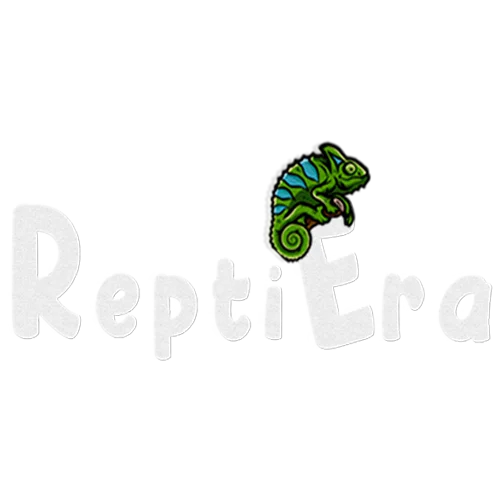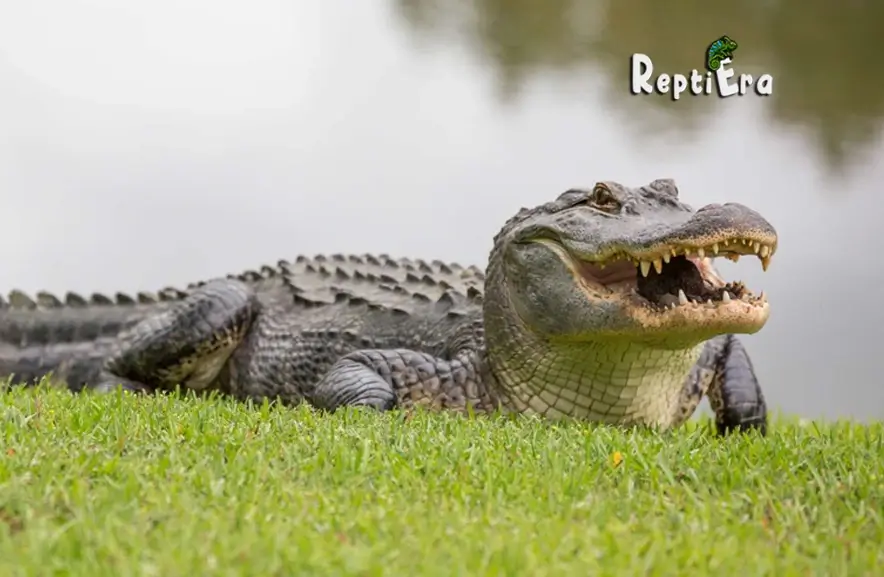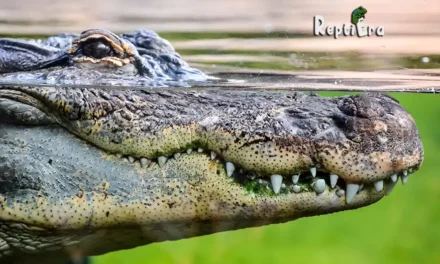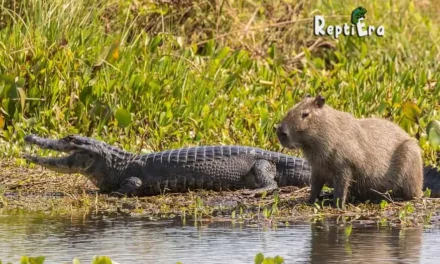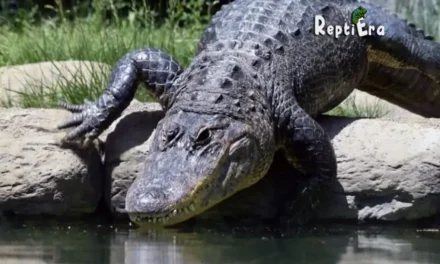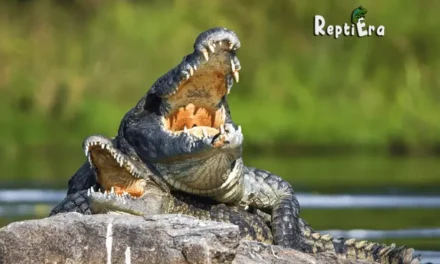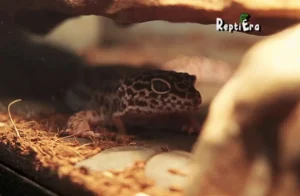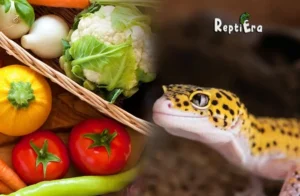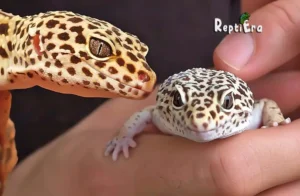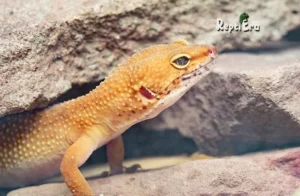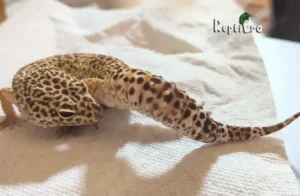In the wild, alligators have a unique feeding schedule, typically eating once a week. These cold-blooded creatures, adapted to survive weeks or even months without food, can efficiently store excess calories in fat deposits near the base of the alligator’s tail.
This ability to sustain itself by burning fat reserves enables an alligator to last more than two years between feedings, a fascinating fact I learned from How Stuff Works.
How Much Do Alligators Eat Per Day?
During a single feeding, an adult allegation can consume up to 18 kilograms of meat or about nine and a half pounds of food per meal. Their diet includes a variety of prey such as gar, turtles, various mammals like coypu and muskrat, as well as birds, deer, and other reptiles. When lakes freeze over, these alligators may hibernate, showcasing their extraordinary adaptability.
Table of Contents
What does an alligator eat?
Alligators, true carnivores, predominantly eat meat. They pose a significant danger to any animal near the water, including Chickens and Cows, which can be grabbed and dragged underwater to drown. Surprisingly, they also consume young Alligators, showcasing cannibalistic behaviour. This opportunistic feeding strategy underscores their adaptability and survival instincts in their natural habitat.
Alligator Diet (Favorite Food)
- Clams
- Crustaceans
- Fish
- Frogs
- Insects
- Mollusks
- Shrimp
- Snakes
- Turtles
- Waterfowl
- Worms
Related post: DO ALLIGATORS EAT EACH OTHER?
Understanding Alligator Behavior: Feeding Habits and Safety Tips
As a cold-blooded creature, the alligator’s eating habits are fascinating. Despite common misconceptions about their poor eyesight, these reptiles actually possess sharp vision, particularly useful for hunting at gloaming or nighttime. Their diet mainly consists of whatever is available, including fish, frogs, small mammals, and sometimes even smaller alligators.
An adult alligator, capable of consuming up to 18 kg of food per meal, tends to eat once a week, averaging around fifty meals a year. It’s interesting to note that they do not like cold weather and can often be seen using their teeth with a strong grip to crush their prey. They have a unique ability to sense movement in the water, which is crucial since they often swim in sedgy and murky waters.
Note: It’s important to stay away from these areas, especially since feeding a wild alligator is not only illegal in Florida but also reduces their natural fear of humans, potentially causing them to diminish their avoidance of human contact.
Alligator Hunting Strategies and Diet: Masters of Stealth and Strength
When it’s time to eat, alligators exhibit remarkable hunting skills, far from being mere hunters or gatherers; they are adept lurkers. They patiently wait for something edible to swim or walk nearby and then lunge with incredible speed. Using their tails to push themselves up to 5 feet out of the water, they skillfully snag small animals from low-hanging tree branches.
In the water, alligators become nearly invisible, lurking in the shadows at the pond’s edge. Their posture makes them impossible to detect, as only their eyes and nostrils stay above the waterline. They can sit for hours, waiting for prey to wander close and then move with startling speed.
Their diet is versatile; they eat almost anything they can capture, ranging from fish, turtles, frogs, birds, and small mammals, to larger mammals like deer. The alligator’s eyes, ears, and skin sensors are equipped to be sensitive to vibration, enabling them to detect anything entering or disturbing the surface of the water.
Note: Once an alligator captures its prey, it holds it in its mouth and drags it underwater to drown. To swallow, it must resurface to prevent its stomach and lungs from filling with water. Utilizing their powerful jaws, which can exert up to 2,000 PSI, they break bones or crush shells (in the case of turtles) to create a manageable chunk of flesh that fits down its throat. After raising its head, it opens the palatal valve to swallow the piece whole, able to digest muscle, bone, cartilage, and more completely.
Alligator Hibernation
During the cold winter months, alligators significantly slow down, especially when temperatures drop below 70 degrees F, leading them to stop feeding. As it gets much colder, they dig a den along the bank of a pond or river and go dormant until it warms up again.
Remarkably adapted to survive freezing conditions, alligators are known to rise to the surface of the water if it’s about to freeze, positioning their nostrils above the ice to breathe as it forms. In extreme cases, they can be frozen into the surface of the pond for several days, only to swim free once the ice melts. For more details, you can see the dedicated page on alligator hibernation and survival strategies.
Also Read: DO ALLIGATORS GO IN SALTWATER
How much do alligators and crocodiles eat?
The amount of food alligators and crocodiles eat can greatly vary. Factors influencing their diet include their size, age, habitat, and food availability. These opportunistic predators adjust their eating habits to accommodate seasonal changes, showcasing a dynamic approach to feeding habits. An overview of their diet reveals a complex interplay between their natural environment and survival strategies.
Alligators
- Alligators are primarily located in the southeastern United States and China, having a narrower range of distribution than crocodiles.
- Alligators have a diverse diet that encompasses fish, birds, mammals, and occasionally, smaller alligators.
- Smaller prey is typically consumed by younger alligators, whereas adult alligators are capable of eating larger creatures.
- Alligators possess a more sluggish metabolism compared to other reptiles, reducing their need for frequent feeding.
Crocodiles
- Crocodiles are found across numerous global regions, spanning Africa, Asia, the Americas, and Australia.
- Crocodiles enjoy a varied diet that encompasses fish, birds, mammals, and a range of other water-dwelling creatures.
- Bigger species of crocodiles, like the Nile and saltwater crocodiles, are capable of hunting down more substantial prey, encompassing large mammals and sometimes fellow crocodiles.
- Crocodiles tend to be more proactive and aggressive in their hunting approach, actively pursuing their prey.
The frequency and amount of food alligators and crocodiles eat depend on several factors, such as the animal’s size and food availability. In captivity, their feeding schedules are managed by caretakers to provide an appropriate and balanced diet.
Wild alligators and crocodiles might eat less frequently, particularly when larger prey provides substantial energy and nutrients to sustain them for longer periods. Their feeding habits vary not only between species but also among individuals. These reptiles have evolved and are well-adapted to survive even when food is scarce, allowing them to go for extended periods without eating.
What do baby alligators eat after their mother brings them to the water?
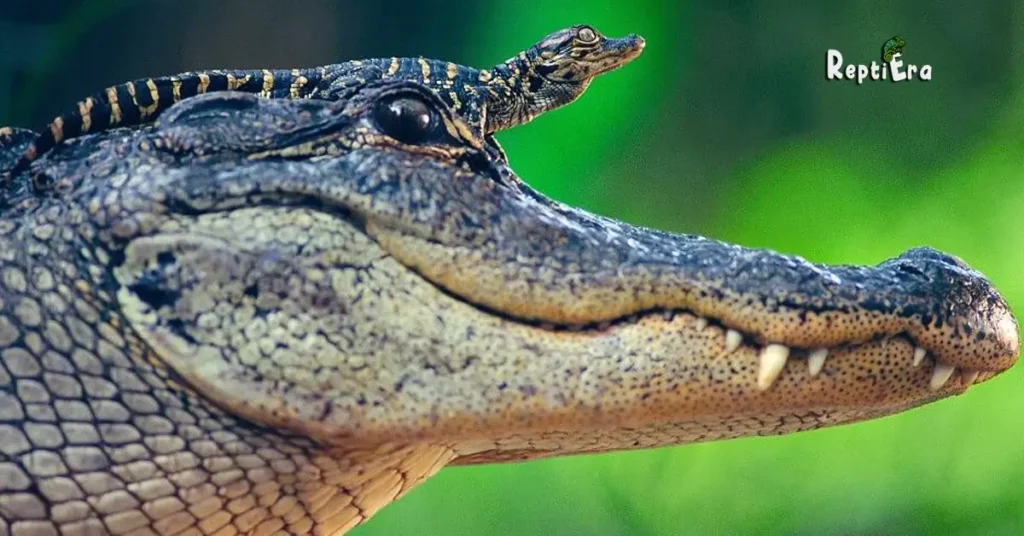
After a mother alligator brings her young to the water, she provides protection but does not feed them, leaving the hatchlings to help themselves right from the beginning. In their first days, baby alligators primarily consume insects, small fishes, crustaceans, and amphibians, with tadpoles being a common choice in the early days.
As they grow, their diet evolves to include birds and small mammals, adapting to their increasing size and changing nutritional needs. This diet is crucial for their growth and development into mature alligators.
Also Read: DO ALLIGATORS EAT CAPYBARAS?
Alligators: Remarkable Survivors from the Age of Dinosaurs
Alligators are amazing animals that have survived for millions of years, a testament to their perfect adaptation to their environment. They are as close as humans will get to witnessing a living dinosaur. Predominantly found in U.S. states like Florida, Georgia, Alabama, and Louisiana, they continue to thrive, leaving us pondering how and why these remarkable creatures have endured so long.
But wait! There’s more
- Alligators have the ability to endure without food for a period of two to three years.
- Alligators stand out as one of the rare reptiles in the modern world that nurture their offspring.
- Alligators possess highly sensitive vibration sensors on their skin, enabling them to perceive even the most minimal vibrations and escape potential danger well in advance.
Alligators, often perceived as dangerous and instinctual living machines, possess a brain that weighs only 8 to 9 grams, roughly the size of one-half a tablespoon. This lack of brain power doesn’t equate to a nice alligator; when hungry, they can eat anything that moves.
Note: Their instinctive behaviour poses a risk, especially to pets and children who wander near a pond, making them frequent victims. Despite their small brain size, alligators’ survival skills and instincts have been honed over millions of years, making them efficient predators in their natural habitat.
Alligators: Evolutionary Marvels with Unique Physical Adaptations
Alligators have thrived for 180 million years, showcasing special features that highlight their evolutionary success. Their armour-plated bodies, fortified with bony plates beneath the skin, known as osteoderms or scutes, make them nearly impervious to penetration.
The distinctive ridges on their back, each spike formed by a bone in that section of skin, can be clearly seen in any photo. These huge, cold-blooded creatures can move surprisingly fast, reaching a top speed of 11 MPH (17 KPH) over short distances. This is quite impressive, especially in comparison to the fastest humans running a world-record 100-meter dash at 20 MPH (32 KPH).
In the wild, this speed enables them to escape various situations on land and quickly get back into the water.
Their eyes feature two sets of eyelids: outer lids similar to human eyelids that close top-to-bottom, and inner lids that are clear and close back-to-front. This unique adaptation allows them to protect their vision in the underwater environment.
Alligators are completely watertight when submerged, with flaps over their ears and nostrils, and a palatal valve at the throat to keep their stomach and lungs free of water. They can stay underwater for a dive lasting 10 to 20 minutes, and in a pinch, they can remain submerged for up to two hours at rest. In cold water, they can survive submerged for up to eight hours.
Also Read: WHAT DO ALLIGATORS AND CROCODILES HAVE IN COMMON?
FAQs
Will Alligators Eat Humans?
Alligators typically do not eat humans and rarely attack them as a source of food. Most instances of fatal attacks are due to protecting their young or responding to aggressive behaviour by a human, but even then, they tend to not eat the human body after it has been killed.
How Much Do Alligators Eat Per Day?
On average, alligators eat about 1 to 3 kg per day, but they can feed on up to 17 kg in a single meal. Eating once per week is often sufficient and enough for them to stay healthy.
Do Alligators Eat Deer?
Alligators do eat deer when the opportunity arises in nature. They often ambush deer that are drinking from water sources, swimming across a river, or walking along a riverbank.
Do Alligators Eat Dogs?
Alligators may eat dogs, particularly when a canine invades their natural habitat. Large alligators have been known to prey on big dogs like Great Danes, German Shepherds, and pit bulls, while average-sized alligators might feed on small dogs, including terriers, poodles, and dachshunds.
How Do Alligators Kill Their Prey?
Alligators typically attack their prey using their powerful jaws and a twist-and-roll technique to inflict severe damage. If the alligator is bigger than its prey, it can complete the kill within a few minutes and then immediately swallow it.
Do Alligators like Marshmallows?
Surprisingly, alligators do like Marshmallows and will eat them when offered. However, it is strongly advised not to feed wild alligators with good intent as it leads to them associating humans, including loved ones, as a source of food, potentially causing them to actively stalk homes and may attack unsuspecting families and neighbours.
Do Alligators Eat Each Other? (isss pr article ka link lagana hai)
Larger alligators will occasionally eat small alligators, especially in times of scarcity. Fights between adult alligators can lead to serious injuries or death, resulting in cannibalism, where the victor may consume the defeated, a behaviour that is not strange among themselves.
Is an alligator has a mass of 400 kg how many calories will it require per day?
According to scientific rumour, under normal conditions, an alligator needs about 3 lbs of food per kilogram to survive. For a 400 kg creature, this equates to approximately 1,200 calories per day, which is slightly below the adult average of 500 calories.
How long does it take an alligator to digest food?
An alligator’s stomach acids have a pH of less than 2, comparable to lemon juice and vinegar, allowing it to digest soft-bodied prey within two to three days. If something like a bone or other hard parts wound up in a gator’s stomach, these could take 13 to 100 days to completely disappear.
How much protein is in 100g of alligator?
A 100-gram (31⁄2-ounce) serving of alligator meat provides significant nutritional value, including 600 kilojoules (143 kilocalories) of food energy, 29 grams of protein, 3 percent fat, and 65 milligrams of cholesterol.
Conclusion
In conclusion, the dietary habits and nutritional needs of alligators present a complex and fascinating aspect of these ancient predators. With a diet that varies from small insects and fish to larger prey like deer and, occasionally, small alligators, these creatures demonstrate remarkable adaptability in their feeding habits.
Alligators have evolved to survive with less frequent meals, consuming 1 to 3 kg of food per day on average and up to 18 kg in a single meal, while efficiently utilizing their energy reserves. Their unique physical adaptations, including powerful jaws and an acidic digestive system, enable them to handle a wide range of prey.
The exploration of alligator meat as a food source for humans reveals its rich protein content, adding another dimension to our understanding of these formidable yet fascinating creatures. Understanding the intricacies of alligator feeding patterns not only sheds light on their survival strategies but also underscores the importance of preserving their natural habitats for the continued balance of our ecosystems.
